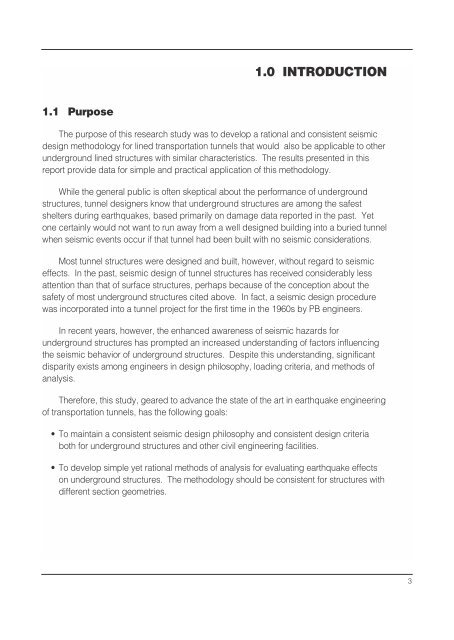Seismic Design of Tunnels - Parsons Brinckerhoff
Seismic Design of Tunnels - Parsons Brinckerhoff
Seismic Design of Tunnels - Parsons Brinckerhoff
Create successful ePaper yourself
Turn your PDF publications into a flip-book with our unique Google optimized e-Paper software.
1.0 INTRODUCTION<br />
1.1 Purpose<br />
The purpose <strong>of</strong> this research study was to develop a rational and consistent seismic<br />
design methodology for lined transportation tunnels that would also be applicable to other<br />
underground lined structures with similar characteristics. The results presented in this<br />
report provide data for simple and practical application <strong>of</strong> this methodology.<br />
While the general public is <strong>of</strong>ten skeptical about the performance <strong>of</strong> underground<br />
structures, tunnel designers know that underground structures are among the safest<br />
shelters during earthquakes, based primarily on damage data reported in the past. Yet<br />
one certainly would not want to run away from a well designed building into a buried tunnel<br />
when seismic events occur if that tunnel had been built with no seismic considerations.<br />
Most tunnel structures were designed and built, however, without regard to seismic<br />
effects. In the past, seismic design <strong>of</strong> tunnel structures has received considerably less<br />
attention than that <strong>of</strong> surface structures, perhaps because <strong>of</strong> the conception about the<br />
safety <strong>of</strong> most underground structures cited above. In fact, a seismic design procedure<br />
was incorporated into a tunnel project for the first time in the 1960s by PB engineers.<br />
In recent years, however, the enhanced awareness <strong>of</strong> seismic hazards for<br />
underground structures has prompted an increased understanding <strong>of</strong> factors influencing<br />
the seismic behavior <strong>of</strong> underground structures. Despite this understanding, significant<br />
disparity exists among engineers in design philosophy, loading criteria, and methods <strong>of</strong><br />
analysis.<br />
Therefore, this study, geared to advance the state <strong>of</strong> the art in earthquake engineering<br />
<strong>of</strong> transportation tunnels, has the following goals:<br />
• To maintain a consistent seismic design philosophy and consistent design criteria<br />
both for underground structures and other civil engineering facilities.<br />
• To develop simple yet rational methods <strong>of</strong> analysis for evaluating earthquake effects<br />
on underground structures. The methodology should be consistent for structures with<br />
different section geometries.<br />
3
















